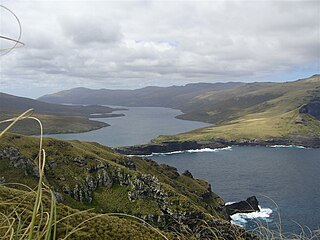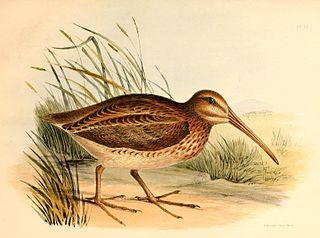
The Auckland Islands are an archipelago of New Zealand, lying 465 kilometres (290 mi) south of the South Island. The main Auckland Island, occupying 510 km2 (200 sq mi), is surrounded by smaller Adams Island, Enderby Island, Disappointment Island, Ewing Island, Rose Island, Dundas Island, and Green Island, with a combined area of 626 km2 (240 sq mi). The islands have no permanent human inhabitants.

Cyanoramphus is a genus of parakeets native to New Zealand and islands of the southern Pacific Ocean. The New Zealand species are often called kākāriki. They are small to medium-sized parakeets with long tails and predominantly green plumage. Most species are forest dwellers, although several of the subantarctic species live in open grassland. The genus formerly had a widely disjunct distribution: while most of the genus ranged from New Caledonia to Macquarie Island, two species were found in the Society Islands, 4,100 km (2,500 mi) away from the rest. Although the islands between these two areas have yielded many bird fossils, undescribed extinct Cyanoramphus have not yet been found on any of them.

Auckland Island is the main island of the eponymous uninhabited archipelago in the Pacific Ocean. It is part of the New Zealand subantarctic area. It is inscribed in the UNESCO World Heritage list together with the other New Zealand Subantarctic Islands in the region.

The yellow-eyed penguin, known also as hoiho or tarakaka, is a species of penguin endemic to New Zealand.

The New Zealand merganser, also known as Auckland merganser or Auckland Islands merganser, was a typical merganser which is now extinct.

The magenta petrel, or Chatham Island tāiko, is a small seabird in the gadfly petrel genus, Pterodroma. Found exclusively on Chatham Island, New Zealand it is one of the rarest birds in the world, believed to be extinct for over 100 years before its rediscovery in the 1970s.

Jacquemart Island, one of the islets surrounding Campbell Island in New Zealand, lies 1 km south of Campbell Island and is the southernmost island of New Zealand.

The double-banded plover, known as the banded dotterel or pohowera in New Zealand, is a species of bird in the plover family. Two subspecies are recognised: the nominate Charadrius bicinctus bicinctus, which breeds throughout New Zealand, including the Chatham Islands, and Charadrius bicinctus exilis, which breeds in New Zealand's subantarctic Auckland Islands.

The Subantarctic snipe is a species of snipe endemic to New Zealand's subantarctic islands. The Maori call it "Tutukiwi". The nominate race C. a. aucklandica is found on the Auckland Islands. Other subspecies include C. a. meinertzhagenae from the Antipodes Islands, and C. a. perseverance from Campbell Island / Motu Ihupuku. The former subspecies from the Snares Islands has been separated as a full species, the Snares snipe, as have the extinct South Island and North Island snipes.

The Chatham penguin, also known as the Chatham crested penguin, Chatham Islands penguin, or Warham's penguin, is an extinct species of crested penguin previously endemic to the Chatham Islands of New Zealand. It is known only from subfossil bones and probably became extinct within 150–200 years after Polynesians arrived in the Chatham Islands around 1500 CE.

Hakawai, also Hokioi in the North Island, was to the New Zealand Māori people, a mythological bird that was sometimes heard but not usually seen. It is now associated with the nocturnal aerial displays made by Coenocorypha snipe.

The Campbell snipe, also known as the Campbell Island snipe, is a rare subspecies of the Subantarctic snipe, endemic to Campbell Island, a subantarctic island south of New Zealand in the Southern Ocean. It was not formally described until January 2010. The subspecific name alludes to the name of the sealing brig Perseverance, captained by Frederick Hasselborough, that discovered Campbell Island in 1810, and which probably inadvertently introduced rats to the island when it was wrecked there in 1828.

The Snares snipe, also known as the Snares Island snipe, or tutukiwi in Māori, is a species of bird in the sandpiper family, Scolopacidae.
The South Island snipe, also known as the Stewart Island snipe or tutukiwi in Māori, is an extinct species of bird in the sandpiper family Scolopacidae that was endemic to New Zealand.

The North Island snipe, also known as the little barrier snipe or tutukiwi, is an extinct species of bird in the sandpiper family, Scolopacidae, that was endemic to New Zealand.
The Antipodes snipe, also known as the Antipodes Island snipe, is an isolated subspecies of the Subantarctic snipe that is endemic to the Antipodes Islands, a subantarctic island group south of New Zealand in the Southern Ocean.

The Auckland snipe, also known as the Auckland Island snipe, is a small bird in the sandpiper family. It is the isolated nominate subspecies of the subantarctic snipe that is endemic to the Auckland Islands, a subantarctic island group south of New Zealand in the Southern Ocean.
The New Caledonian snipe is an extinct species of austral snipe, described from late Holocene cave deposits on the French island of New Caledonia in the western Pacific Ocean. The specific epithet is a latinisation of the name of its island home.




















